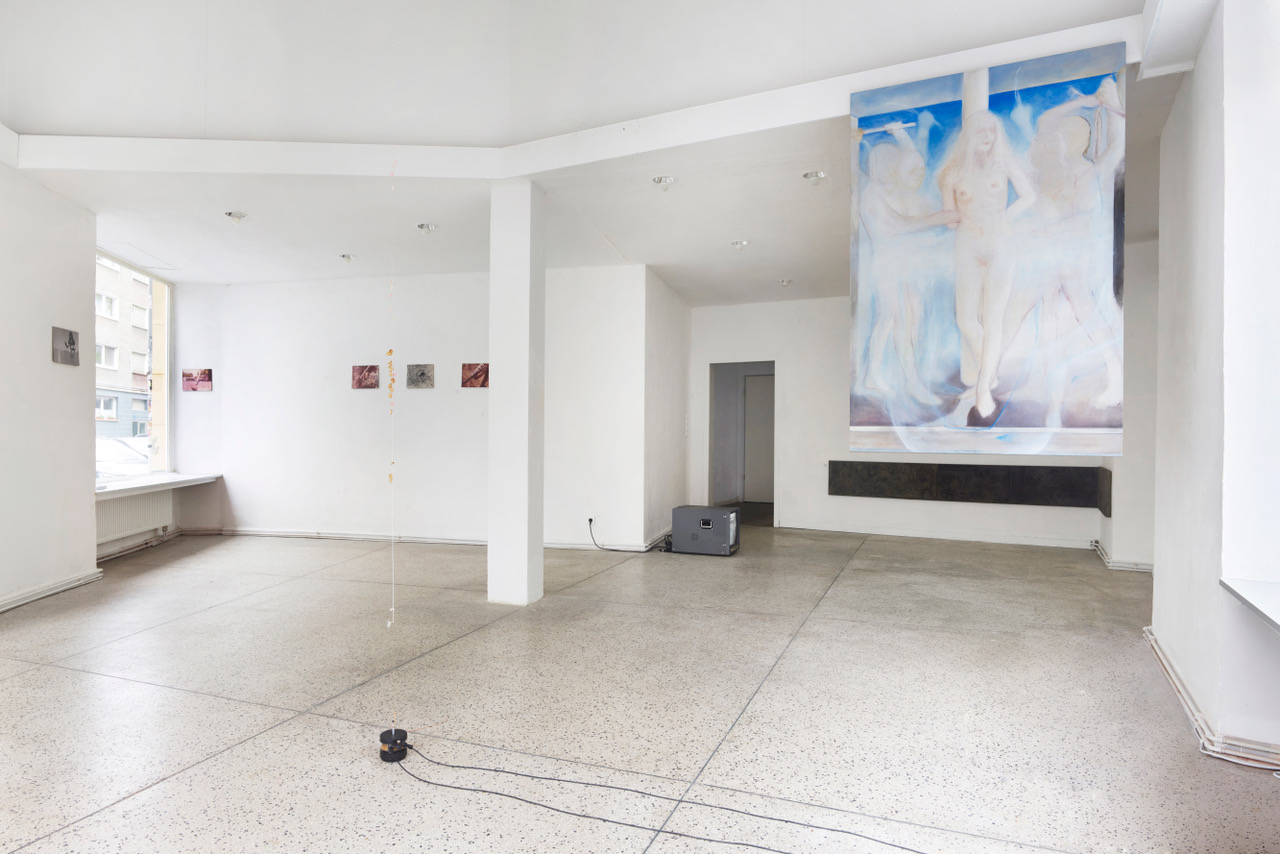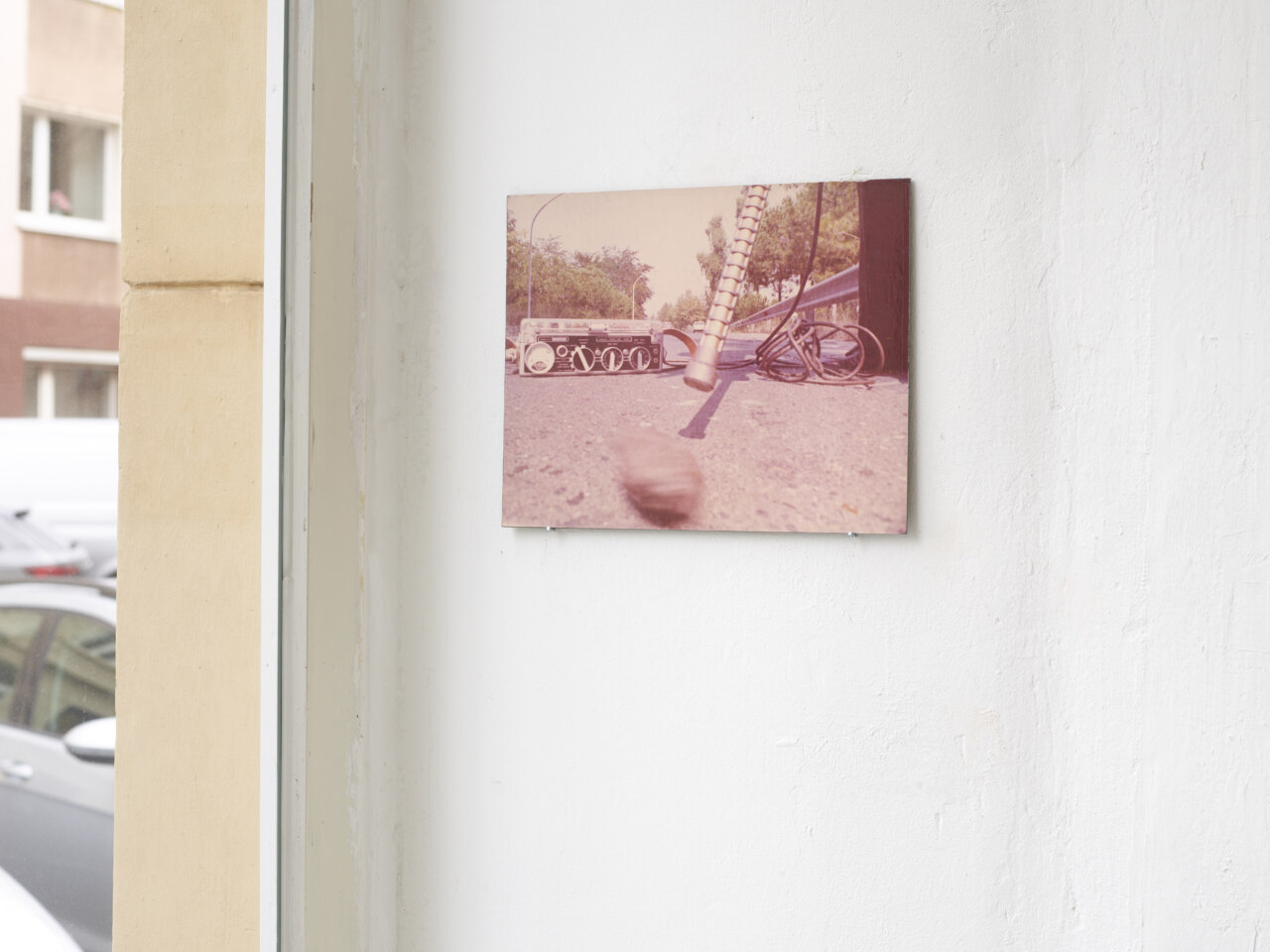For this show, we invite a contemplation of obsession as an integral part of the artistic pursuit. The theme is understood as a way of practising art rather than as a characteristic of an artwork. We stray away from imposing a singular meaning of an obsessive practice but rather open a conversation about what forms it may take. The artist’s voice is, therefore, key. We are pleased to present works by Nina Canell, Wanda Czełkowska, Letícia Parente, Joanna Woś, Maria Loboda, and Laura Grisi. The interaction between the selected works establishes a visual language that merges bodies with practices, disturbs the line between creator and creation, and invites an obsessive gaze. The flesh and the mind become tools and points of reference.
Nina Canell’s (b. 1979 Sweden) practice draws up parallels to scientific experimentation, however, not one intended in the name of invention but rather in transmitting an emotional charge. She uses kinetic energy as a key agent in her sculptural process. The electrical tools and currents become alienated from their utilitarian purpose and instead are instigators or receivers of a visceral reaction. The sculpture is stretched between the ceiling and a vibrating generator on the floor which in turn connects to a frequency generator that induces electrical impulses that travel along the wire, the nails, and the nutshells, causing a micro-spasmic percussion between the elements as they interact with each other. The shocks reappear and force an extreme reaction in the pistachio shells. The thin and delicate thread is being shaken by the electric waves. It withstands it nevertheless – an obsessive practice of strong will.
Joanna Woś (b. 1991 Poland) invites the audience into a universe where fear, lust, disgust, and desire intertwine. Her unconstrained, and expressive motifs combine autobiographical themes with traces of self-irony, focusing on corporeality, and sexuality, with a touch of surrealism. In this work, Woś borrows the religious motif from historical painting depicting the flagellation of Christ. Flagellation is defined as “flogging or beating, either as a religious discipline or for sexual gratification”. A distinct gradation – from horror to pleasure. Instead of Jesus’ body, she paints a nude woman. The artist is contemplating the positions of victim and perpetrator, testing the boundaries between dominance and subordination. The scene dissects the line between what’s permitted or not, forcing viewers to tap into what’s below the surface; the fear, the emotion, the desire. The private sphere takes over the gallery space invoking a provocative viewing experience.
Wanda Czełkowska (1930 – 2021 b. Poland) remains a largely underappreciated artist whose practice demonstrates an unequivocally original approach to sculpture. She began her career whilst Socialist Realism was the enforced style for the Eastern Bloc, nevertheless, she created her own unique visual language. Czełkowska’s vocabulary expresses avant-garde undertones, conversing with currents from neoprimitivism, expressionism, and conceptualism. Her forms carry a strong visceral power projected through their sensual bodies. While Czełkowska was a sculptor, her practice escapes the static borders of this category. She produced a vast amount of paintings and drawings that can be seen as extensions of her three-dimensional silhouettes. In her work, it is the emotional energy that occupies the foreground, while the objecthood and the figurative value fade into the background. The drawing provides a glimpse into the immense study of spatial relations and an obsessive mastering of the medium. Her gestures have a repetitive presence; reappearing in different moments, they refuse to be dismissed.
Laura Grisi’s (1931-2017 b. Greece) practice encapsulates a wide variety of mediums and styles, escaping the boundaries of categorization. She “embodies a stateless and nomadic female subject who defies the politics of identity, the univocity of representation, and the unidirectionality of time” (Krzysztof Kościuczuk for Susch Museum). She is known for artificially reproducing natural phenomena in gallery and museum contexts. Impossible tasks – counting sound grains, recreating the flow of air, classifying pebbles – lie at the heart of her practice. The natural question arresting the viewer’s mind while observing Grisi’s action is “what for?”. For “Sounds,” Grisi recorded the noises of ants moving. The effect: sounds and photographs from the process. Systems are of great importance here. Perhaps when we can’t grasp our own purpose, we should focus on that of smaller creatures. Find some patterns. Find some answers. But cautiously because what we might discover is that there aren’t any.
At 40 years old, with a professional background in chemistry, Letícia Parente (1930-1991 b. Brazil), expanded the scope of her laboratory to include artistic expression. Today, she is known as one of the pioneers of Brazilian video art. “In” shows Parente hanging a sweater that she is wearing, and so coincidentally hanging herself, inside a closet. Her bodily performance comments on the stereotypical connection between a female subject and domesticity. The home is shown as a symbol of both freedom and confinement. Parente’s son, André Parente, describes his mother’s work as “marked with the idea of drawing from the body an image that gives us a reason to believe in the world we live in. Her videos are preparations and tasks through which the body reveals the models of subjectivity, models that imprison”. Her local context: Brazil under a military dictatorship. In a system that rested upon a subordination of mind and body, Parente preserves her autonomy through artistic performance. She chooses to remove herself from the outside world, to tuck herself away as you would a sweater. The absurdity acquires a radical sensibility. By incorporating her flesh in this action, Parente ingests it only to disrupt it from within.
Maria Loboda (b. 1979 Poland) is interested in facts hidden below the surface, in stories that escape the mainstream narratives, and in the interplay of cultural and epistemological symbols. In her practice, Loboda embodies an excavator, unpacking layers of meaning usually stemming from the fields of poetry and history. Through the deconstruction and reorganisation of common codes and forms, Loboda represents a unique voice in what is described as contemporary archaeology. “An exceptional and rare wall frieze in the Scythian style” represents one of Loboda’s obsessive studies. For its preparation, the artist documented hundreds of sgraffito reliefs from different cultures and periods. She then recreated the existing images, carving them onto the concrete. What we see is an extensive collection of sgraffito copies like writings from Pompeii, some vandal engravings from the Egyptian pyramids and Greek temples, demonological texts, mediaeval apotropaic symbols, and amateur graffiti from the streets of Paris. This one object becomes a holder and in a way a guardian of an assemblage of collective memories that otherwise
would have never been placed in conversation with each other.
Mela Miekus

Nina Canell
Pistachio Pangolin on the Continuous Fingernail Transmitter, 2020
vibration generator, frequency generator, cables, string, pistachio shells, fake fingernails
dimensions variable

Laura Grisi
Sounds, 1971
2 b/w vintage photographs and 3 color vintage photographs mounted on board
24 x 30,5 cm each, + 4 tracks, 15 minutes each

Laura Grisi
Sounds, 1971
2 b/w vintage photographs and 3 color vintage photographs mounted on board
24 x 30,5 cm each, + 4 tracks, 15 minutes each

Laura Grisi
Sounds, 1971
2 b/w vintage photographs and 3 color vintage photographs mounted on board
24 x 30,5 cm each, + 4 tracks, 15 minutes each

Laura Grisi
Sounds, 1971
2 b/w vintage photographs and 3 color vintage photographs mounted on board
24 x 30,5 cm each, + 4 tracks, 15 minutes each

Laura Grisi
Sounds, 1971
2 b/w vintage photographs and 3 color vintage photographs mounted on board
24 x 30,5 cm each, + 4 tracks, 15 minutes each

















